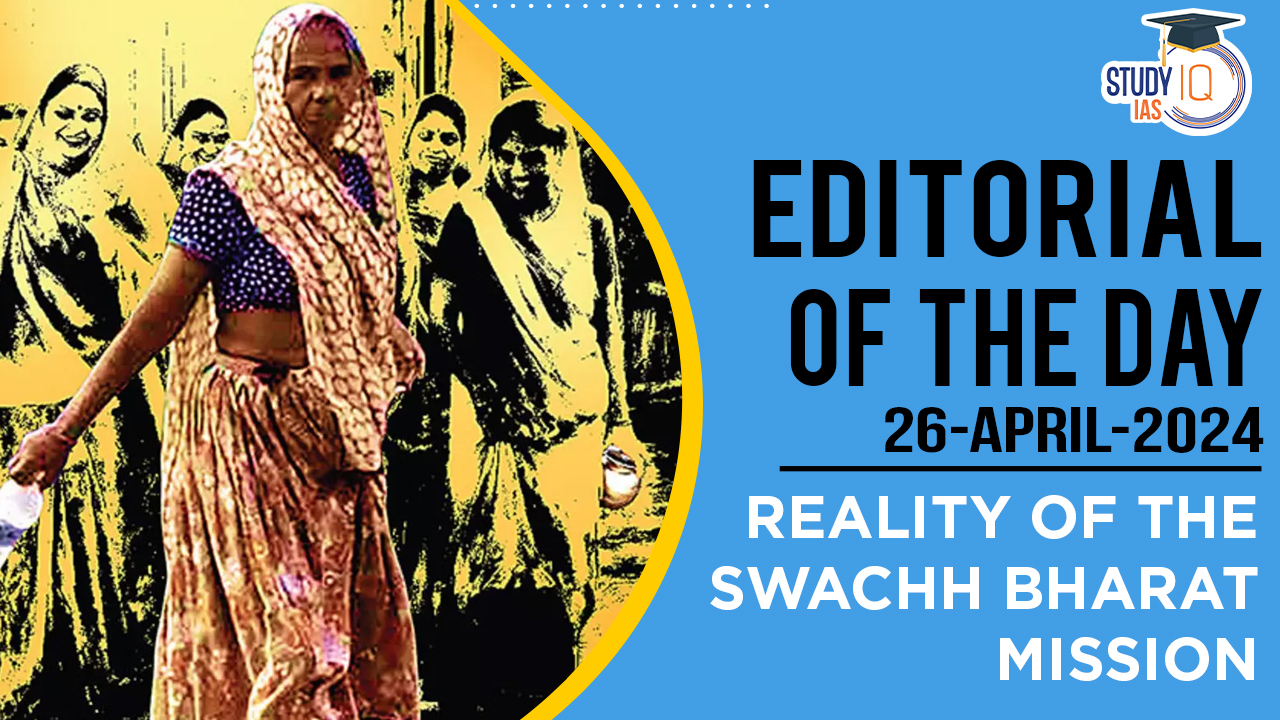Table of Contents
Context: India was ranked right at the bottom of 180 countries in the Environment Performance Index (EPI) in 2022 which raised questions regarding the effectiveness of the Swachh Bharat Mission.
About Swachh Bharat Mission (SBM): Clean India Mission
- Launched: 2014
- Goal: Achieve universal sanitation coverage and eradicate open defecation by October 2nd, 2019, as a tribute to Mahatma Gandhi’s 150th birth anniversary.
- Components:
- Swachh Bharat Mission (Gramin) (SBM(G)) – Rural:
- Implemented by the Ministry of Drinking Water and Sanitation
- Aims to improve cleanliness through solid and liquid waste management
- Aims to make villages Open Defecation Free (ODF)
- Swachh Bharat Mission (Urban):
- Implemented by the Ministry of Urban Development
- Focuses on urban sanitation
- Swachh Bharat Mission (Gramin) (SBM(G)) – Rural:
Phases
- SBM Phase I (2014-2019):
- Achievements:
- Over 10 crore individual household toilets constructed
- Sanitation coverage increased from 39% (2014) to 100% (2019)
- Around 6 lakh villages declared ODF
- Contributed to economic, environmental, and health benefits
- Helped achieve UN Sustainable Development Goal (SDG) 6.2 (Sanitation and Hygiene) 11 years early
- SBM Phase II (2020-present):
- Focuses on:
- Safe management of solid and liquid waste
- Sustainability of ODF status
- Aims to transform villages from ODF to ODF Plus by 2024-25 (ODF Plus: sustains ODF status and implements solid/liquid waste management)
- Achievements:
- 75% villages have achieved ODF Plus status
- 14 States/UTs have achieved 100% ODF Plus villages
- Focuses on:
- Achievements:
Challenges of the Swachh Bharat Mission (Clean India Mission)
- Behavioural Change: Deep-rooted cultural attitudes and behaviours regarding cleanliness are difficult to shift.
- Sustained education and awareness campaigns are needed to promote hygienic practices like proper waste disposal and toilet use.
- Infrastructure Development: Building sufficient sanitation infrastructure, particularly toilets and waste management systems in rural areas, is a significant hurdle.
- Remote and economically disadvantaged regions require substantial investment and logistical planning to ensure facilities are available.
- Infrastructure Maintenance: Constructing toilets is not enough; proper upkeep and ongoing use are essential.
- Many toilets built under SBM suffer from poor maintenance and non-functionality due to a lack of ownership or user awareness.
- Open Defecation: Open defecation persists in certain areas due to: Lack of awareness, Cultural practices, Inadequate toilet facilities.
- Addressing these behaviours requires not only infrastructure but also community engagement and communication strategies.
- Waste Management: Proper solid and liquid waste management is crucial for cleanliness and preventing environmental pollution.
- However, inadequate infrastructure and systems for waste collection, segregation, and disposal lead to littering and water source contamination.
- Funding and Resources: Sufficient funding and resources are critical for SBM’s success.
- While the government has allocated significant funds, ensuring effective utilisation and allocation at the local level remains a challenge.
Moving Forward
- A multi-pronged approach is needed, involving:
- Government intervention.
- Active community participation.
- Cooperation from civil society organisations and other stakeholders.
- Sustainable solutions addressing the root causes of sanitation and cleanliness issues are essential.
- Continuous monitoring and feedback mechanisms are crucial for the long-term success of the Swachh Bharat Mission.


 SSC MTS Salary 2025, Check Highest Salar...
SSC MTS Salary 2025, Check Highest Salar...
 F-35 Fighter Jet Stranded in Kerala: Dis...
F-35 Fighter Jet Stranded in Kerala: Dis...
 Quad Summit 2025: Key Announcements, Str...
Quad Summit 2025: Key Announcements, Str...





















